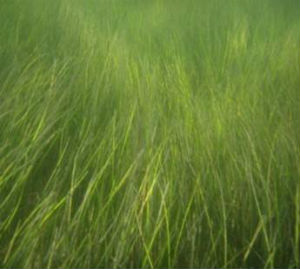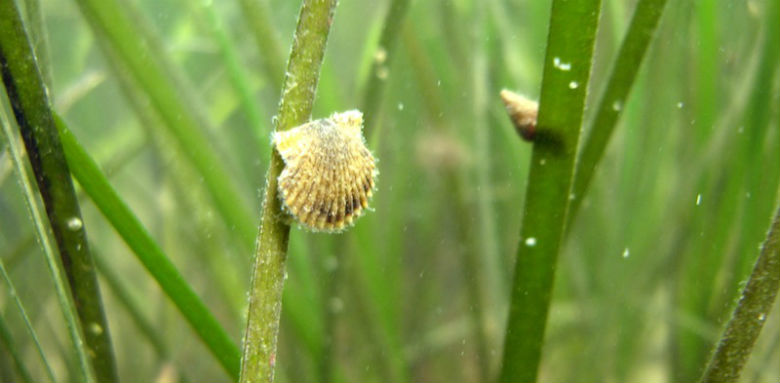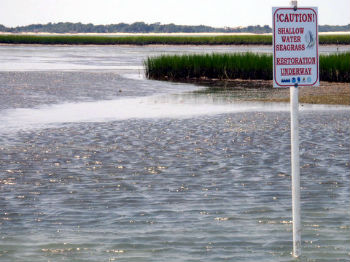OCRACOKE — A gusty winter wind tugged at my jacket as I scrambled along the shore of Pamlico Sound, gathering up handfuls of dead, grayish seagrass and stuffing them into a brown paper sack. I filled four bags before turning back and heading home, pleased with myself and day-dreaming about a spring garden.
I would soon tuck the eelgrass in the sacks around my dormant plants. The mulch would protect them and eventually break down into a nutritious fertilizer. I have been mulching my flowers and vegetables with seagrass, washed up on soundside beaches, since I moved here years ago. Its value as a garden-enhancer, however, is tiny compared to the grass’ immense importance to our coastal environment.
Supporter Spotlight
If you look out across the great expanse of Pamlico Sound, you can see buffleheads swimming and diving, least terns plummeting into the dark waters or the head of an occasional diamond back terrapin popping above the water’s surface. There is little indication from above, however, of the wealth of life that may lie below. Only a few feet below the surface, expansive beds of eelgrass and shoal grass form underwater gardens where life flourishes. The estuaries of coastal North Carolina have about 200,000 acres of these aquatic plants. Known to scientists as submerged aquatic vegetation, or SAV, they play an important role in safeguarding the entire coastal ecosystem.
 Shoal grass beds are less common in North Carolina estuaries than eelgrass. Photo: Seagrass Recovery |
More than 150 species of fish and marine invertebrates – 30 are important commercial species — use these grasses as adults or juveniles. The grass beds are nurseries for blue crabs, pink shrimp and spotted sea trout and provide habitat for juvenile fish and small species such as mummichogs and pipefish. The beds form hunting grounds for larger predators such as flounders, red drum and rays. Shellfish such as bay scallops attach to the surface of these seagrasses before reaching adulthood. Waterfowl such as brant and widgeons depend on eelgrass as an important food source.
The grasses also enhance the health of other marine habitats by providing oxygen for coastal waters, reducing turbidity and lessening the effects of turbulence. Their roots stabilize the bottom and the grasses themselves reduce storm damage to shoreline by lessening wave action. Eelgrass is also an efficient biological filter that removes harmful pollutants from the water.
Changes in seagrass coverage can be a sensitive indicator of water quality and overall estuary health, said Mark Fonseca, a scientist with NOAA’s Southeast Fisheries Science Center in Beaufort. He calls them “the canaries of the estuaries.”
There are at least 50 species of seagrasses, but here in North Carolina’s estuaries the main ones are Zostera marina , or eelgrass, and to a lesser degree Halodule wrightii, or shoal grass. Coastal North Carolina is a unique blend, for it is on the southern-most boundary of the eelgrasses and the northern-most extent of shoal grass. Most beds in the state occur in waters less than six feet deep because of their requirements for light. They need clear water to survive.
Supporter Spotlight
Seagrasses are not true grasses, being more closely related to lilies. They are flowering plants. The flowers of eelgrass are enclosed in sheathes at the leaves’ bases and their fruits are bladder-like and will float. Shoal grass is among the most grass-like of the different species. Sea grasses live in a harsh environment, with their roots fixed in a bottom of sulfide-ridden sediments toxic to most plants, forming underwater meadows.

A small scallop clings to a blade of eelgrass. Photo: John Carroll
During the 1930s there was a massive die-off of eelgrass in northern Atlantic waters. Ninety percent of the beds were lost to what was called the “wasting disease.” Its causes are still not fully understood. There has been some recovery since then, but seagrasses are still a matter for concern. Here in North Carolina, the more eastern beds of grasses, which have high salinity, seem to be stable with possible exceptions in southern estuaries. Beds nearer the coast, however, in the western parts of Pamlico, Albemarle, and Currituck sounds, have been in decline since the 1970s, with losses of 50 percent or more in these low salinity areas. Studies show that grasses are declining on a national and global level.
While the reasons for the decline are not fully understood, scientists think that runoff from the mainland is the main cause. It overloads the estuaries with nutrients and sediment overload, which leads to excessive amounts of nitrates in the water and a reduction in light. Warmer water temperatures are also believed to contribute, causing reduced grass shoot density, a decrease in leaf and root development and alterations in internal carbon and nitrogen compositions. Disturbance by channel dredging, filling submerged bottoms and trawling in areas of grass cause further decline, and the effects of climate change and sea level rise are now being assessed.
 The Rachel Carson Reserve near Beaufort has been the site of a seagrass restoration effort whose partners include the N.C. Coastal Federation. Photo: N.C. Coastal Reserve. |
The distribution, abundance and density of seagrasses vary seasonally and from year to year, making it more difficult to monitor and protect, noted Patricia Smith, a spokeswoman for the N.C. Division of Marine Fisheries. Mounting concern over the health and well-being of the grass beds and the life that depends on them has led to new efforts to protect them. State agencies have been mapping the beds since 1981, and recent mapping efforts using sophisticated GPS devices have identified at least 139,000 acres of SAV along 75,000 miles of coastal shoreline.
In 2006 an agreement was signed by 25 state agencies, universities and conservation groups, creating the N.C. SAV Partnership, dedicated to promoting conservation efforts to protect the state’s submerged grass beds.
The N.C. Habitat Protection Plan, which was updated in 2010, identifies the protection of the grasses as a priority. It has determined that “the monetary value of the ecosystem services provided by SAV, such as waste management, food production, and climate regulation are very high.” The plan contains new information on the ecological understanding of eelgrass and shoal grass, including the light and water quality conditions needed for healthy grass beds.
Plans to protect and improve the grass habitat include the maintaining strong rules to control stormwater, a modified definition for seagrasses and revising rules for building docks. Certain kinds of fishing gear are prohibited in grass beds, including trawlers, oyster and clam dredges, hand tongs and clam rakes more than a foot wide. The state does not permit shellfish leases or the seeding of oyster cultch in grass beds SAV and rules prohibit new dredging and filling in areas with grass beds.
Seagrasses are also protected by the U.S. Corps of Engineers, which in 2012 implemented new regulations which forbid the disturbance of grass beds.
With the current levels of concern and the actions being taken for their protection, it is hoped that North Carolina’s underwater gardens of eelgrass and shoal grass will remain stable or increase, thus ensuring the many benefits they provide







